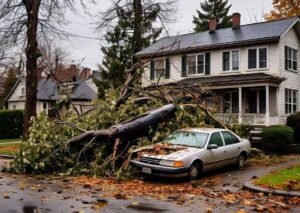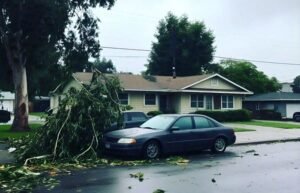Whether it’s a severe winter storm or the result of natural growth, sometimes trees can become a hazard to your property, especially in places like Duluth, MN, where the climate can be unpredictable. While trees add beauty, shade, and wildlife to your yard, when they’re unstable or compromised, they can cause significant damage if left unchecked. That’s where emergency tree removal comes in.
So, when should you consider emergency tree removal? Let’s dive into this topic, and we’ll even sprinkle in a few interesting statistics to help paint a clearer picture.
Why Does Emergency Tree Removal Matter?
 In Duluth, we experience harsh winters, heavy snow, and strong winds. These extreme weather conditions are tough on trees. In fact, Minnesota experiences around 8-10 major storms each year, with an average of 50 to 70 mph wind gusts during the winter months. Those conditions can easily cause trees to fall or become unstable, posing risks to your property and loved ones.
In Duluth, we experience harsh winters, heavy snow, and strong winds. These extreme weather conditions are tough on trees. In fact, Minnesota experiences around 8-10 major storms each year, with an average of 50 to 70 mph wind gusts during the winter months. Those conditions can easily cause trees to fall or become unstable, posing risks to your property and loved ones.
When a tree becomes a hazard, emergency removal is often necessary. But it’s not always easy to tell when a tree is a danger. Let’s take a closer look at some common scenarios that call for emergency tree removal.
Read More: Tree Removal Duluth MN
1. Fallen Trees from Storms
One of the most obvious reasons for emergency tree removal is when a tree falls. Fallen trees are a common issue in Duluth, especially during or after storms. According to a 2023 report by the National Weather Service, Minnesota saw over 50,000 incidents of tree-related damage due to severe weather conditions, with many of those incidents causing property damage or injury.
If a tree has fallen on your home, garage, power lines, or driveway, you’re going to need immediate professional help to clear the debris. In many cases, there’s also the risk of electrical hazards, so it’s best to stay clear and call experts like us to handle the situation.
2. Leaning Trees
A tree that’s leaning dangerously could indicate that its roots are compromised, either due to poor soil conditions, disease, or past storm damage. According to the University of Minnesota Extension, trees that have tilted by more than 15 degrees are at risk of toppling, especially after heavy rain or snow. The danger is real: if a leaning tree hasn’t yet fallen, it might just be one strong gust of wind away from doing so.
In cases like this, it’s important to get an expert evaluation. If the tree’s stability is questionable, the best course of action is to remove it before it causes any damage.
3. Damaged or Dead Trees
When a tree becomes diseased or suffers damage that can’t be repaired, it may become a safety risk. Dead trees, for example, lose their structural integrity, and the risk of limbs breaking or the entire tree collapsing increases.
In Duluth, with its challenging growing conditions, trees like ash are particularly vulnerable to pests like the emerald ash borer. This invasive beetle has destroyed over 10 million trees in the U.S. over the past two decades, including significant numbers in northern Minnesota. Trees that are severely infested or decaying should be removed as soon as possible to avoid any unexpected collapses, especially during winter months when snow load can make trees more prone to breaking.
4. Overhanging Branches
Overhanging branches that reach over your roof, power lines, or a pathway pose a risk if they break or fall. Even healthy trees can suffer from high winds or snow accumulation that causes branches to snap. The risk of these branches damaging your property, power lines, or vehicles is high, particularly if you live in an area with heavy snow or wind gusts.
 Did you know? According to the Insurance Institute for Business & Home Safety, falling trees and branches are responsible for nearly $1 billion in property damage annually in the U.S. alone. A small investment in regular tree trimming and inspections can prevent much larger costs down the road.
Did you know? According to the Insurance Institute for Business & Home Safety, falling trees and branches are responsible for nearly $1 billion in property damage annually in the U.S. alone. A small investment in regular tree trimming and inspections can prevent much larger costs down the road.
5. Trees That Block Driveways or Roads
A fallen or leaning tree blocking access to your driveway or public road can create an immediate safety hazard. In Duluth, especially during the snowy winter months, it’s critical to have clear access for emergency vehicles, or even just to get out for work or school. If a tree is blocking your access, we recommend immediate removal to ensure that you and your neighbors are not left stranded or facing potential delays.
What Should You Do in an Emergency?
If you encounter any of these situations, here’s what you should do:
- Stay Safe: Keep a safe distance from the tree, especially if it’s near power lines. Fallen trees can also have sharp or broken branches that could be hazardous.
- Contact a Professional: Emergency tree removal requires the right equipment and expertise. Our team is available 24/7 to help you with fallen trees, leaning trees, or any other tree-related emergency. We’ll quickly assess the situation and take care of it before it causes further damage.
- Avoid DIY Attempts: It might be tempting to take matters into your own hands, but removing a fallen or dangerous tree can be dangerous, particularly if the tree is large or near power lines. Leave it to the pros who are trained to handle these situations safely.
The Bottom Line: Don’t Wait Until It’s Too Late
When it comes to tree emergencies, time is of the essence. Ignoring the signs of a dangerous tree can lead to costly damage to your property, your neighbor’s property, or even worse, injury. If you notice signs of tree instability, or if a storm has recently damaged a tree, don’t wait. Call us for a professional assessment and prompt tree removal.
Duluth’s unique climate presents challenges for tree health and safety, but with the right care, you can avoid costly damages and keep your property safe. Ready to get that tree checked out? Give us a call today! We’re here for all your emergency tree removal needs—rain, snow, or shine.
